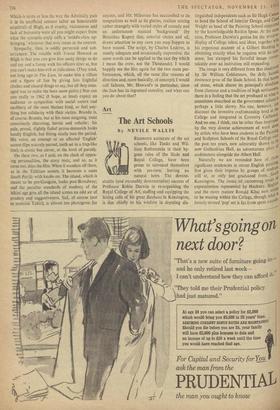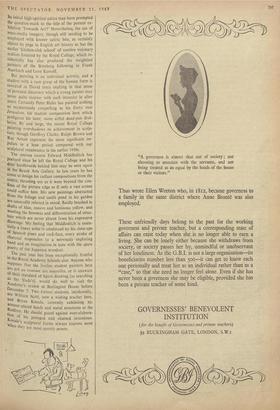Art
The Art Schools
By NEVILE WALLIS RIGOROUS autocrats of the art tinguished independents such as Sir Hugh Casson to head the School of Interior Design, and Carel Weight as head of the Painting School supported by the knowledgeable Ruskin Spear. At the salve time, Professor Darwin's genius for the windoW" display of College talent and ideas, together with his imperious manner of a Gilbert Harding 111 obtaining exactly what he requires with no no?' sense, has stamped his forceful image unmts takably over an institution still expanding. The image is very different from that shadowed by Sir William Coldstream, the drily WOO eminence grise of the Slade School. In that Well of stone, which shares its principal's aloofness from clamour and a tradition of high seriousness' there is a feeling that the art produced at what sometimes described as the government school Is perhaps a little showy. No one, however, can discount the inventive craftsmanship bred at the College and integrated in Coventry Cathedral' And no one, I think, can be other than impressed by the very diverse achievement of work ,clone by artists who have been students in the Painna and Sculpture Schools of the Royal College ove1 the past ten years, now admirably shown in Its new Gulbenkian Hall, an adventurous piece of architecture alongside the Albert Hall. Naturally we are reminded here of th, °56 significant tendencies in recent English Paintil first given their impetus by, groups of students still at, or only just graduated from, .5°Litt Kensington.. The ironic or, cartooning roOde expressionism represented by Hockney, 13.011jes and the more mature Ronald Kitaj now, seems be waning within the .College, though wlit loosely termed 'pop' art is far from spent outside. Its initial high-spirited antics may have prompted the question-mark to the title of the present ex- hibition 'Towards Art?' Nevertheless, the use of Mass-media imagery, though still needing to be employed with keener satiric bite, as certainly claims its page in English art history as has the earlier 'kitchen-sink school' of sombre visionary realism fostered by the Royal College, which in- cidentally has also produced the weightiest painters of the Bomberg following in Frank Auerbach and Leon Kossoff.
But painting is an individual activity, and a student with a rare grasp of the human form is revealed in David Innis exulting in that sense of personal discovery which a young painter may never quite recover with such intensity in after years. Certainly Peter Blake has painted nothing so mysteriously compelling as his Entry into Jerusalem, his student composition here which prefigures his later, more artful dead-pan drol- leries. By and large, the recent Royal College painting overshadows its achievement in sculp- ture, though Geoffrey Clarke, Ralph Brown and Ray Arnatt represent the more significant im- pulses in a lean period compared with our sculptural renaissance in the earlier 1950s.
The uneven course Edward Middleditch has pursued since he left the Royal College and his dour hardboards behind him may be seen again at the Beaux Arts Gallery. In late years he has come to design his radiant compositions from the centre, thrusting out as it were beyond the con- fines of the picture edge as if only a vast screen could suffice him. His new paintings abstracted from the foliage and sunlit pond in his garden are unusually relaxed in mood, fluidly brushed in shafts of blue, mauve and luminous yellow, and wanting the firmness and differentiation of struc- ture which are never absent from his. expressive drawings. My feeling that Middleditch is essen- tially a linear artist is reinforced by his close-ups of Spanish pines and rock-face, every stroke of charcoal responsive to a nervously ' exploring hand and an imagination in tune with the spare Poetry of the Japanese woodcut.
The past year has been exceptionally fruitful in the Royal Academy Schools also. Anyone who suPposes that the livelier student painters here are not au courant des nouvelles, or is unaware of their standard of figure drawing (as searching as the Slade's), would do well to visit the _Academy's review at Burlington House before December 7. Two former students, incidentally, are William Scott, now a visiting teacher here, and Bryan Kneale, currently exhibiting his _armour-plated heads and metal structures at the Redfern. He should guard against over-elabora- tion of his pronged and chained inventions. Kneale's sculptural forms always impress most when they are most sparely severe.











































































 Previous page
Previous page